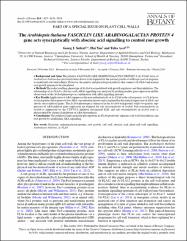| dc.contributor.author | Seifert, Georg J. | |
| dc.contributor.author | Xue, Hui | |
| dc.contributor.author | Acet, Tuba | |
| dc.date.accessioned | 2019-12-18T06:51:28Z | |
| dc.date.available | 2019-12-18T06:51:28Z | |
| dc.date.issued | 2014 | |
| dc.identifier.issn | 0305-7364 | |
| dc.identifier.issn | 1095-8290 | |
| dc.identifier.uri | https://doi.org/10.1093/aob/mcu010 | |
| dc.description.abstract | Background and Aims The putative FASCICLIN-LIKE ARABINOGALACTAN PROTEIN 4 (At-FLA4) locus of Arabidopsis thaliana has previously been shown to be required for the normal growth of wild-type roots in response to moderately elevated salinity. However, the genetic and physiological pathway that connects At-FLA4 and normal root growth remains to be elucidated. Methods The radial swelling phenotype of At-fla4 was modulated with growth regulators and their inhibitors. The relationship of At-FLA4 to abscisic acid (ABA) signalling was analysed by probing marker gene expression and the observation of the At-fla4 phenotype in combination with ABA signalling mutants. KeyResults Application of ABA suppresses the non-redundant role of At-FLA4 in the salt response. At-FLA4 positively regulates the response to low ABA concentration in roots and is required for the normal expression of ABA- and abiotic stress-induced genes. The At-fla4 phenotype is enhanced in the At-abi4 background, while two genetic suppressors of ABA-induced gene expression are required for salt oversensitivity of At-fla4. Salt oversensitivity in At-fla4 is suppressed by the CYP707A inhibitor abscinazole E2B, and salt oversensitivity in At-fla4 roots is phenocopied by chemical inhibition of ABA biosynthesis. Conclusions The predicted lipid-anchored glycoprotein At-FLA4 positively regulates cell wall biosynthesis and root growth by modulating ABA signalling. | en_US |
| dc.description.sponsorship | Austrian Science FundAustrian Science Fund (FWF) [P21782-B12, I1182-B22]; China Scholarship CouncilChina Scholarship Council; Council of Higher Education; Austrian Science Fund (FWF)Austrian Science Fund (FWF) [P 21782] Funding Source: researchfish | en_US |
| dc.description.sponsorship | We thank Isabel Damm (University of Applied Sciences, Wr. Neustadt) for assistance with RT-PCR, and Jose M. Estevez (University of Buenos Aires, Argentinia) for critical reading of the manuscript. We gratefully acknowledge the generous gift of abscinazoles by Yasushi Todoroki (Shizuoka University, Japan). Bjoern Ost Hansen (Max Planck Institute for Molecular Plant Physiology, Golm, Germany) provided an RNaseq-based co-expression matrix for At-FLA4. This work was supported by the Austrian Science Fund (P21782-B12, I1182-B22). H. X. was supported by the China Scholarship Council. T. A. was supported by The Council of Higher Education (PhD Research Scholarship), Turkey. G.J.S planned and conducted the research and wrote the manuscript; H. X. and T. A. conducted the research and critically read the manuscript. | en_US |
| dc.language.iso | eng | en_US |
| dc.publisher | Oxford Univ Press | en_US |
| dc.relation.ispartof | Annals of Botany | en_US |
| dc.rights | Attribution 3.0 United States | * |
| dc.rights | info:eu-repo/semantics/openAccess | en_US |
| dc.rights.uri | http://creativecommons.org/licenses/by/3.0/us/ | * |
| dc.subject | [No Keywords] | en_US |
| dc.title | The Arabidopsis thaliana FASCICLIN LIKE ARABINOGALACTAN PROTEIN 4 gene acts synergistically with abscisic acid signalling to control root growth | en_US |
| dc.type | article | en_US |
| dc.relation.publicationcategory | Makale - Uluslararası Hakemli Dergi - Kurum Öğretim Elemanı | en_US |
| dc.description.wospublicationid | WOS:000344359600008 | en_US |
| dc.description.scopuspublicationid | 2-s2.0-84903557277 | en_US |
| dc.department | Gümüşhane Üniversitesi | en_US |
| dc.authorid | ACET, Tuba / 0000-0002-0981-9413 | |
| dc.authorid | Seifert, Georg / 0000-0002-4245-791X | |
| dc.identifier.volume | 114 | en_US |
| dc.identifier.issue | 6 | en_US |
| dc.identifier.startpage | 1125 | en_US |
| dc.identifier.doi | 10.1093/aob/mcu010 | |
| dc.identifier.endpage | 1133 | en_US |
| dc.authorscopusid | 35876333500 | |
| dc.authorscopusid | 57214811087 | |
| dc.authorscopusid | 56242240900 | |
| dc.description.pubmedpublicationid | PubMed: 24603604 | en_US |




















